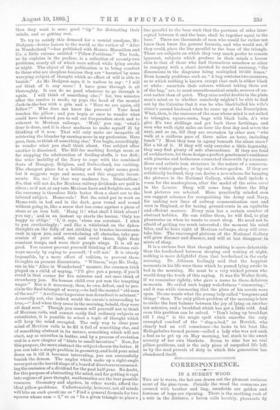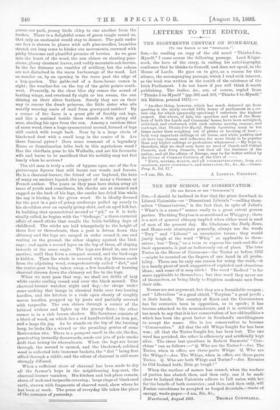CORRESPONDENCE.
THE air is warm, the hot sun draws out the pleasant resinous scent of the pine-trees. Outside the wood the commons are covered with heather and ling, cornfields are golden and festoons of hops are ripening. There is the soothing rush of a weir in the distance, a heron calls harshly, pheasants fly
across our path, young birds chirp to one another from the bushes. There is a delightful sense of green tangle round us, that only an anatomist would stay to dissect. The path under our feet is strewn in places with soft pine-needles, brambles stretch out long arms to hinder onr movements, crowned with pinky blossoms and plentiful promise of berries. As we gaze into the heart of the wood, the sun shines on slanting pine- stems, glossy chestnut leaves, and ruddy mountain-ash berries. In the far distance are rumbles of artillery, but the echoes are not disturbed in the warm harbourage of the wood. Let us wander on, by an opening in the trees past the edge of a hop-garden. The gable-end of a farm-bouse comes in sight ; the weather-fox on the top of the gable points south- west. Presently, in the clear blue sky comes the sound of beating wings, and overhead fly eight or ten swans, the sun shining on their silver feathers. Surely they are on their way to rescue the dumb princess, the little sister who sits wearily weaving coats of mail from graveyard nettles P By a corner of the farm is a great pile of freshly cut loge, and like a sentinel beside them stands a thin grimy old man, shading his eyes from the sun. Among a careless litter of sawn wood, rises a huge symmetrical mound, formed of loge still coated with rough bark. Near by is a large circle of blackened dust with a small heap in the centre of it. Are these funeral pyres P Does some remnant of a legendary Norse or Scandinavian tribe lurk in this mysterious wood P Has the chieftain gone to his Walhalla, and are his favourite wife and horse to be sacrificed that his nobility may not feel lonely when he arrives P
The old man is truly a relic of bygone ages, one of the few picturesque figures that still haunt our woods and forests. He is a charcoal-burner, the friend of our boyhood, the hero of many an ancient legend, the puppet of many a German or French author. The years as they pass have stolen away all trace of youth and comeliness, his cheeks are as seamed and rugged as the bark of his logs, the smoke has dried him while the sap is hissing in the green wood. He is ideally dressed for the part in a pair of grimy corduroys pulled up nearly to his shoulders over an equally grimy shirt, and an aged felt hat. In building that symmetrical mound or "pit," as it is tech- nically called, he begins with the " birdcage," a three-cornered affair of small sticks that recalls the brick-building days of childhood. The sticks are laid triangularly to the height of three feet or thereabouts, then a post is driven down this chimney and the logs are ranged in order round it, one end resting on the ground, the other sloping against the bird- cage ; and again a second layer on the top of these, all sloping inwards at the same angle. The logs are fitted in, one over another, until they form a compact mound, and the bird-cage is hidden. Then the whole is covered with dry fibrous earth from the adjoining wood, comprehensively called " dirt," and the centre-post being taken away, a few handfuls of burning charcoal thrown down the chimney set fire to the logs.
When we next pass that way, we shall see drifts of lazy white smoke curling round and over the black mound. The charcoal-burner watches night and day,—he sleeps under some sacking that hangs in classical folds over two leaning hurdles, and his kitchen is a rude open shanty of roughly woven hurdles, propped up by posts and partially covered with tarpaulin. The sun shines through a corner of the latticed withies and lights up the grassy floor ; the other corner is in a rich brown shadow. His furniture consists of a block of wood, on which lies a red handkerchief, an iron pot, and a large tin jug. As he stands on the top of the burning heap, he looks like a wizard or the presiding genius of some Rosicrucian rite. There is a pungent smell in the air, the fire, penetrating inwardly downwards, sends out jets of pale smoke drift that betray its whereabouts. When the logs are burnt through, the mound is opened, and the blackened, calcined wood is collected into immense baskets, the " dirt " being first sifted through a riddle, and the odour of charcoal is still more strongly diffused.
When a sufficient store of charcoal has been made to dry all the farmer's hops in the neighbouring hop-oast, the charcoal-burner vanishes. His kitchen and bed-place remain, shorn of sack and tarpaulin covering ; large rings of blackened earth, strewn with fragments of charred wood, show where he has been at work. The prose of everyday life takes the place of the romance of yesterday.



































 Previous page
Previous page